Cypress is a common name for various coniferous trees or shrubs of northern temperate regions that belong to the family Cupressaceae. The word cypress is derived from Old French cipres, which was imported from Latin cypressus, the latinisation of the Greek κυπάρισσος (kyparissos). Cypress trees are a large classification of conifers, encompassing the trees and shrubs from the cypress family (Cupressaceae) and many others with the word cypress in their common name. Many cypress trees have needle-like, evergreen foliage and acorn-like seed cones.

Hesperocyparis arizonica, the Arizona cypress, is a North American species of tree in the cypress family Cupressaceae, native to the southwestern United States and Mexico. Populations may be scattered rather than in large, dense stands.
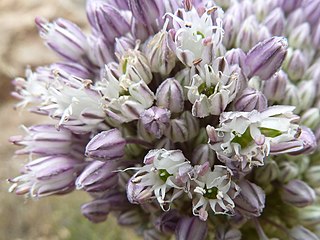
Allium ampeloprasum is a member of the onion genus Allium. The wild plant is commonly known as wild leek or broadleaf wild leek. Its native range is southern Europe to southwestern Asia and North Africa, but it is cultivated in many other places and has become naturalized in many countries.

Hesperocyparis bakeri, previously known Cupressus bakeri, with the common names Baker cypress, Modoc cypress, or Siskiyou cypress, is a rare species of western cypress tree endemic to a small area across far northern California and extreme southwestern Oregon, in the western United States.
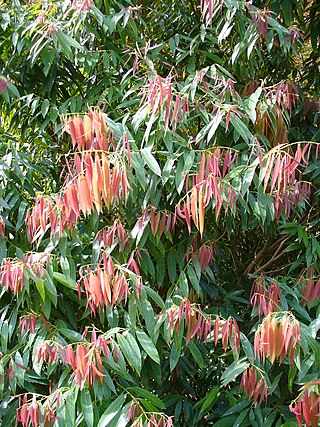
Mesua is a genus of flowering plants in the family Calophyllaceae, native to tropical southern Asia. Common names include ironwood and rose chestnut.

Cylindropuntia is a genus of cacti, containing species commonly known as chollas, native to northern Mexico and the Southwestern United States. They are known for their barbed spines that tenaciously attach to skin, fur, and clothing. Stands of cholla are called cholla gardens. Individuals within these colonies often exhibit the same DNA, as they were formerly tubercles of an original plant.

Resedaceae is a family of mostly herbaceous dicotyledonous plants comprising 107 known species in 8 to 12 genera.
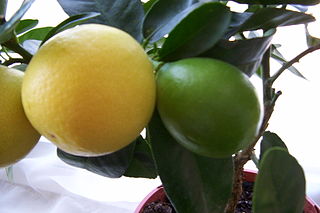
Walter Tennyson Swingle was an American agricultural botanist who contributed greatly to the classification and taxonomy of citrus.

Rheum officinale, the Chinese rhubarb, or Indian rhubarb is a rhubarb from the family Polygonaceae native to China. In Chinese it is called yào yòng dà huáng, literally meaning medicinal rhubarb.
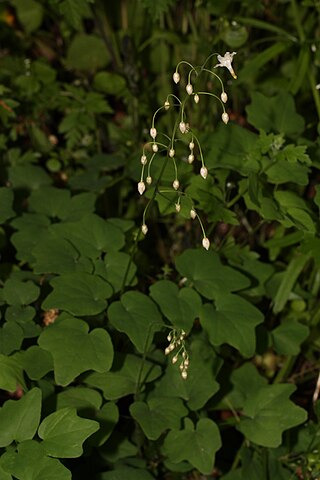
Vancouveria is a small group of plants belonging to the barberry family described as a genus in 1834. The three plants in this genus are known generally as inside-out flowers, and they are endemic to the West Coast of the United States. The genus was named after George Vancouver, English navigator and explorer.
- Vancouveria chrysanthaGreene – golden inside-out flower – California, Oregon
- Vancouveria hexandra(Hook.) C.Morren & Decne. – white inside-out flower – northwestern California, western Oregon, southwestern Washington
- Vancouveria planipetalaCalloni – redwood inside-out flower – California as far south as Monterey County, southwestern Oregon

Linnaea is a plant genus in the honeysuckle family Caprifoliaceae. Until 2013, the genus included a single species, Linnaea borealis. In 2013, on the basis of molecular phylogenetic evidence, the genus was expanded to include species formerly placed in Abelia, Diabelia, Dipelta, Kolkwitzia and Vesalea. However, this is rejected by the majority of subsequent scientific literature and flora.

Imperata is a small but widespread genus of tropical and subtropical grasses, commonly known as satintails.
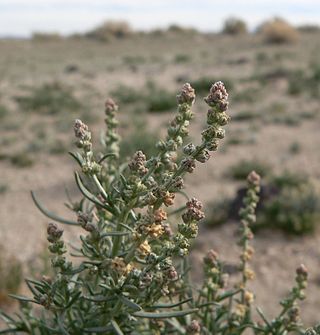
Oligomeris linifolia is a species of flowering plant in the small family Resedaceae known by the common name lineleaf whitepuff. It is native to parts of the Middle East and the Indian subcontinent, as well as southern Europe and North Africa, and the southwestern United States and northern Mexico. It grows in many types of habitat, including disturbed areas and saline soils, in deserts, plains, coastline, and other places. It is a fleshy annual plant, producing several erect, ribbed stems 35 to 45 centimeters in maximum height.
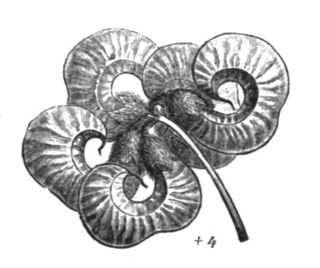
Dorycnopsis is a genus of flowering plants in the legume family Fabaceae. It belongs to the subfamily Faboideae. It includes two species of subshrubs, one native to southwestern Europe and Morocco, and the other native to the Horn of Africa and Yemen.

Limonium vulgare, called common sea-lavender, is a species of flowering plant in the genus Limonium native to Atlantic parts of Europe from southwestern Sweden to southwestern Iberia, and introduced elsewhere. A clumping perennial found in salt marshes and other maritime habitats, it is a probable species complex that includes Limonium maritimum and L. narbonense.
Veronica verna is a species of flowering plant belonging to the family Plantaginaceae.
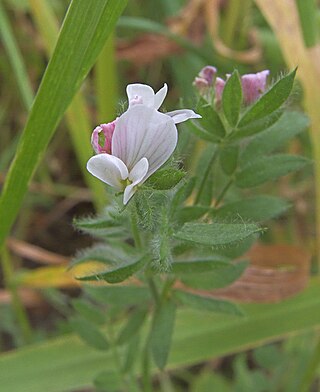
Ornithopus sativus, the serradella or common birdsfoot, is a species of flowering plant in the family Fabaceae. It is native to Southwestern Europe and Northwest Africa in Portugal, western Spain, northern Morocco and Algeria, and southwestern France and has been introduced as a legume forage to many locations around the world, including most of central and eastern Europe, Turkey, the Caucasus, the Azores, South Africa, Kenya, Java, most of Australia, the North Island of New Zealand, southern Chile, and California. It is known for producing a high‑quality forage in highly acidic, nutrient‑poor soils.
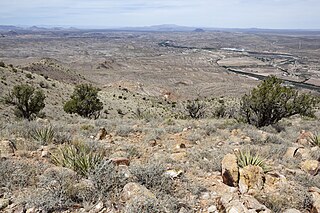
Juniperus arizonica, the Arizona juniper, is a species of conifer in the family Cupressaceae, native to the Sonoran Desert of the southwestern United States and northwestern Mexico. It is a shrub or small tree, reaching 8 m (26 ft).

Pelargonium grandiflorum is a species of flowering plant in the family Geraniaceae, native to the southwestern Cape Provinces of South Africa. It may be a parent of the cultivated Pelargonium × domesticum with Pelargonium cucullatum.
















